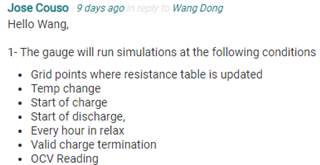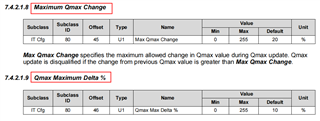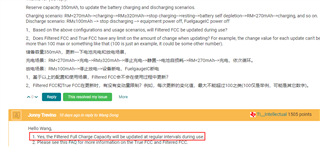Hello,
We use a degraded battery and insert it directly into the device, the Filtered Fcc obtained by FuelgaugeIC does not match the actual one.
Example: An aged battery with a fully charged capacity of 110mAh is inserted into the device and the Filtered Fcc obtained by FuelgaugeIC is 865mAh.
Our configuration: cutoff voltage 3V, reserve capacity 350mAh, battery capacity 1230mAh. loaded Fs file has been uploaded.
Battery usage scenario:
The battery is used as a backup power source, and the battery is only turned on to discharge when the main power is low or disconnected. The vast majority of the time it is mains powered.
Battery power will not be full or discharged.
Charging scenario: soc<19% --> charging --> soc=30% --> stop charging --> rest --> battery self depletion --> soc<19% --> charging
Discharge scenario: soc=8% --> stop discharging --> device powered off, FuelgaugeIC powered off
1、Based on the above configuration and usage scenarios, will Filtered FCC be updated during usage?
2、Based on the above description, if the degraded battery is directly inserted into the device, what operation steps will enable FuelgaugeIC to accurately obtain the information of the degraded battery?
我们使用劣化电池直接插入设备中,FuelgaugeIC获取到的Filtered Fcc与实际不符。
实例:满充電容量为110mAh的老化电池,插入到设备上,FuelgaugeIC获取到的Filtered Fcc为865mAh。
我们的配置:截止电压3V,储备容量350mAh,电池容量1230mAh。加载的Fs文件已经上传。
电池的使用场景:
电池作为备用电源,主电电量低或断开后,才会开启电池放电。绝大部分时间都是主电供电。
电池电量不会充满,也不会放空。
充电场景:soc<19%-->充电-->soc=30%-->停止充电-->静置-->电池自损耗-->soc<19%-->充电
放电场景:soc=8%-->停止放电-->设备断电,FuelgaugeIC断电
1、基于以上的配置和使用场景,Filtered FCC会不会在使用过程中更新?
2、基于以上描述,如果劣化电池直接插入设备中,什么操作步骤可以使FuelgaugeIC准确的获取到劣化电池的信息?









